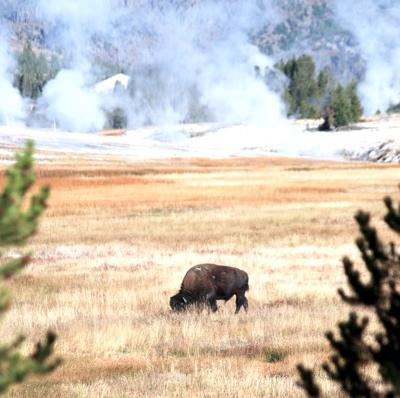Can the grasslands in Yellowstone National Park support the park's bison herds? That's a question that researchers from Syracuse University will examine during a three-year study into bison grazing habits in the iconic park.
Just gazing out across the Hayden Valley in summer it doesn't seem as if bison are exerting great pressure on Yellowstone's grasslands. Certainly, the herds don't blacken the prairie like some described in the mid-19th century.
But the grazing habits of bison and their increasing numbers have raised questions about the long-term stability of the park's grasslands. To find answers, the National Park Service has partnered with Syracuse University biologist Douglas Frank, who has studied the effects of climate change and herbivores on the park's grasslands during the past two decades.
"During the late 1980s, similar concerns were raised about the size of the park's elk herd and whether the herd was negatively impacting grasslands," Dr. Frank, a professor in SU's College of Arts and Sciences, said in a release from the university. "Rather than having a negative impact on the grasslands, we found that increases in elk grazing actually stimulated plant growth."
The upcoming study will focus on grazing areas most frequented by bison and will incorporate ecological research techniques that were pioneered at Syracuse University, according to the release. The biologist will also work with Yellowstone staff to develop a long-term grasslands monitoring system using these same research methods.
"Fossil records indicate that prior to the industrial revolution, the Earth's grasslands and large herds of migratory herbivores coexisted for millennia," Dr. Frank said. "These systems were stable, despite having sustained very intense levels of grazing. My work in Yellowstone explores why and how this happens."
According to the biologist, past studies have found that intensive grazing triggers several mechanisms that actually increase plant growth. For example, increases in the amount of elk feces and urine on heavily grazed areas provide an easily available source of nutrients for plants, as compared to ungrazed areas, the university release noted.
"Grazing also spurs plants to produce new shoots and grow new leaves. Younger, more numerous leaves and shoots are more photosynthetically active than older leaves on un-grazed areas," the release said. "Consequently, grazing stimulates both shoot and root growth and increases grassland vitality."
Dr. Frank pointed out that heavy grazing boosts the amount of nitrogen in decomposing leaf material.
"The high-quality litter is quickly broken down by soil bacteria, which in turn enriches the soil around grazed plants," the biologist said.
Intensive grazing -- such as that done by large herds of bison -- also can trigger important reactions between roots and bacteria, according to the university.
"These simple compounds, which are made of sugars and amino acids, are like cotton candy for soil microbes," said Dr. Frank. "The microbes thrive on the compounds."
In a case of what-goes-around-comes-around, the microbes "use the food energy from the compounds to decompose organic material in the soil around the roots, which then results in a new source of nutrients for plants," the release pointed out.
Dr. Frank plans to head to Yellowstone in the spring to fence areas of grassland that will become test plots for the study. Each fenced-in area will be about a 15-yard square and will be left untouched for a year, according to the university. During the ensuing two years, some areas will be clipped at various intensities to mimic natural grazing. Plant data obtained from the fenced areas will be compared with adjacent areas as well as with areas of the park where natural grazing varies in intensity depending on the time of the year, the university said.
"The study will be very similar to the one we did 20 years ago on elk grazing," Dr. Frank said. "It will be interesting to see if we reconfirm our original findings or whether we find something new. We also intend to use this opportunity to better understand the complex and fascinating ways in which the interactions among plants, herbivores and soil organisms foster the stability of grassland systems."




Comments
The park service has apparently chosen not to listen to Dr. Frank in the past, the Northern Yellowstone elk herd has shrunk from about 19,000 head in 2000, to about 4,000 in this Winter of 2011. The Park service seems to agree with these numbers, with most of the decrease of elk to wolf predation. Lets be clear here, I'am not against predators, but there eating themselves out of house and home, and numbers show the wolf population in this area also shrinking. Buffalo are about the only big grass eaters left in the Northern part of the Park, they have been prosecuted the last 5 years due to false Brucellosis scare, when leaving the Northern part of the Park for Winter forage. Hopefully Dr. Frank's study will find the same results as the first study done 20 years ago, and the buffalo won't become a target.